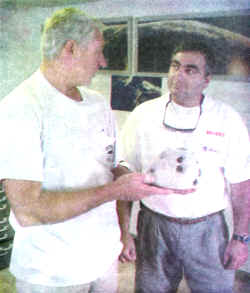
September 12, 2000

Environmental thinking

KENNY PEKRUN (right), a marine fisheries technician with the N.C. Department of Environment, Health and Natural Resources, and Manteo Commissioner Stuart Wescott discussed on Monday the limitless possibilities of placing artificial reef balls off the Outer Banks coast. The aquarium reef ball being held by Wescott is a miniature model of the 500 pallet reef balls currently being constructed in Wanchese. (N. Garrett photo)
500 artificial reef balls nearly ready to be sunk By NOAH GARRETT
Exactly 500 artificial reef balls currently being constructed in Wanchese are almost ready to be dumped offshore as another reef site maintained by the N.C. Division of Marine Fisheries.
Marine Fisheries Technician Kenny Pekrun, of the N.C. Department of Environment, Health and Natural Resources, said the 500 reef balls are just one example of the types of artificial structures used to enhance sand bottom areas offshore.
According to North Carolina's Artificial Reef Guide, durable and stable material such as concrete pipe, ships, barges, and prefabricated structures are colonized by small marine organisms soon after settling in the water.
Once the smaller creatures begin to flourish, small bait fish begin feeding. When the bait fish arrive, the bigger predatory fish follow which nearly completes the new oceanic habitat in just a short time period.
On top of using reef balls, other materials including sea vessels, train boxcars, boat mold and surplus military aircraft are used to make artificial reefs. In this location in particular, Pekrun said the rubble from the new Croatan Sound bridge construction is being used.
The 500 reef balls, which cost more than $100 a piece to build, are being built by Reef Innovations. The Florida-based company was expected to pour concrete over the molds in Wanchese yesterday (Monday) afternoon.
The artificial reef program receives funding and support from the North Carolina General Assembly as well as private donations for construction costs.
The funding for coordination, permitting, and buoying of artificial reefs is obtained by the U.S. Fish and Wildlife Service through the Federal Aid in Sportfishing Restoration Program.
The 500 reef balls waiting to go into the water, are scheduled
to go offshore this fall. Last fall, several hundred similar reef balls were dumped several miles off the Outer Banks coastline.
However, some are worried that the shifting sandy bottom may affect the reef balls.
After several dives, the shifting sands have apparently not harmed last year's reef ball deposit.
Skillful preparation

A WORKER for Reef Innovations, an artificial reef company based in Florida, prepared these pallet reef ball molds Monday morning by dumping dirt and sand inside the structures. The dirt and sand was said to prevent the concrete from leaking out of the bottom of the molds when it is poured over them. (N. Garrett photo)